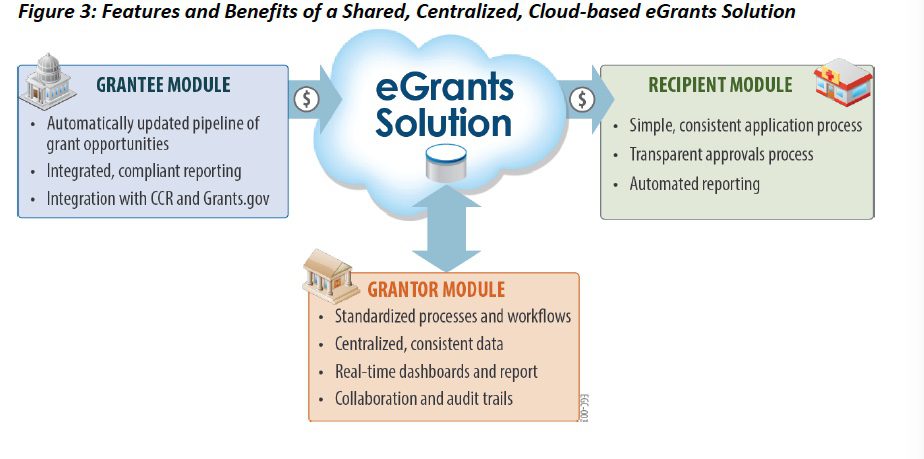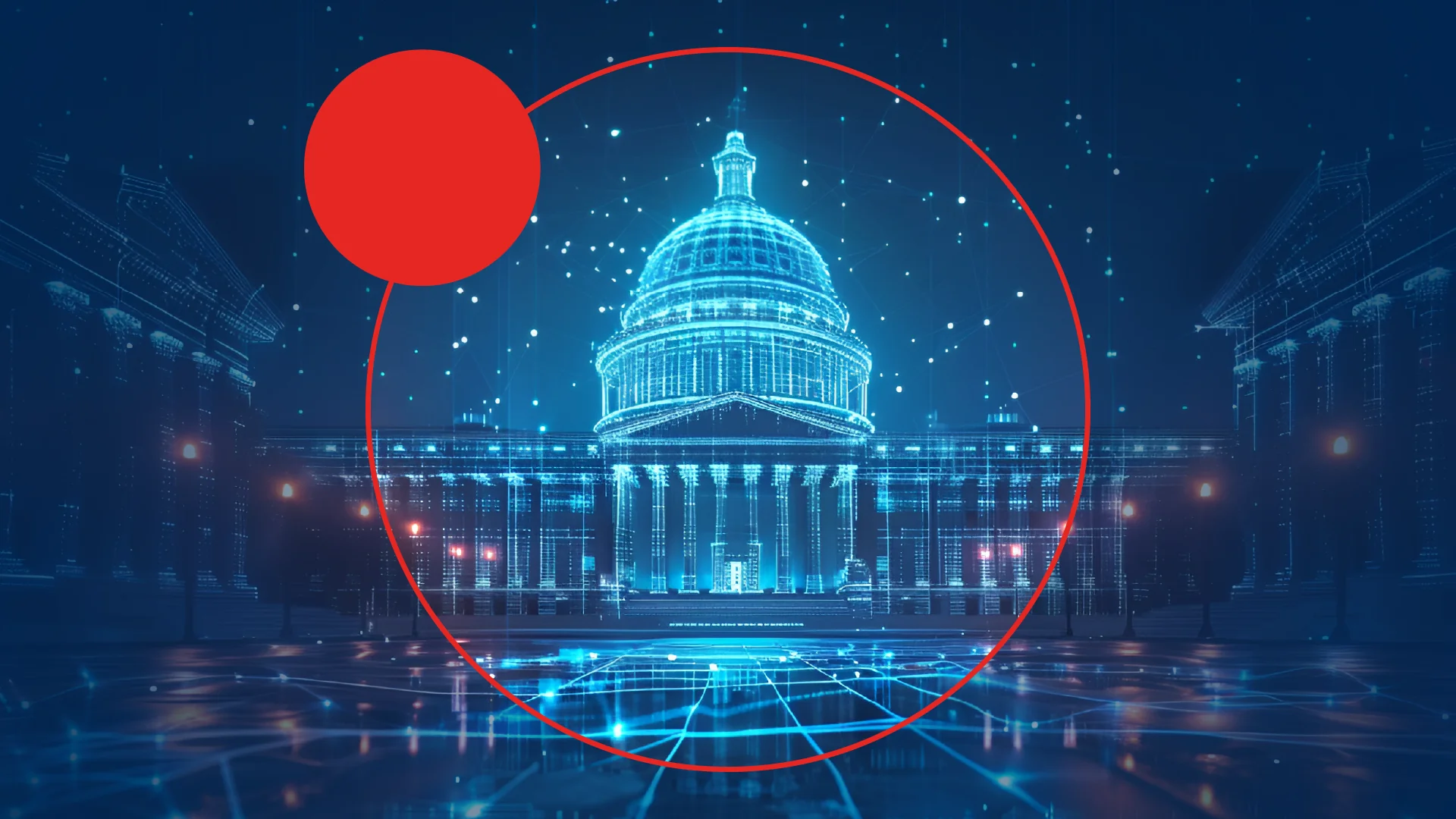Introduction
During the fiscal year 2012, the U.S. federal government spent $539.4 billion through grant programs, mostly through state and local (S&L) governments. The federal government has undertaken numerous initiatives to automate and improve its grants management process, including Grants.gov.
While the federal government has achieved a greater degree of process standardization and efficiency in enterprise-wide eGrants systems, many S&L governments have not.
Achieving process automation and improving methods for obtaining and disbursing grants is critical for S&L governments. They are under mounting pressure to demonstrate success in getting more grant money and distributing it compliantly while cutting operating costs.
The amount of grant money distributed varies widely from state to state (Fig. 1). High-award states often have a federal grants management office or automated system to maximize their opportunities to receive federal grants.
This white paper examines the challenges faced by S&L governments’ grants management offices, evaluates their options, and recommends adopting a modern cloud-based eGrants solution. Such a solution can be secure, easy to adopt and enable S&L governments to achieve efficiencies without a significant IT investment.
1. Unique State and Local Grants Management Challenges
Business Challenges. Unlike federal eGrants systems, which focus on disbursing money to grantees, S&L systems must enable S&L governments to function as grantees, applying for and receiving grants, and as grantors, distributing grants within their jurisdiction (Fig. 2). The systems support three different user communities: federal granting entities; S/L program managers and administrators; and community recipients. This dual role, along with multiple user communities, presents the following key challenges:
- Missed Opportunities. Functionality is focused on the grantor business process, so S&L governments miss chances to apply for federal grants.
- Decentralized Processes. Different workflow assignments and approval processes across the government make standardization challenges.
- Difficult Reporting. Timely, accurate, and shareable data for reporting, policymaking, and results evaluation is difficult without an enterprise-wide view of information.
Technology Challenges. S&L governments with existing eGrants systems have usually deployed either custom systems or commercial off-the-shelf (COTS) applications that are heavily customized to their business processes. Both these solutions have resulted in problems like:
- Redundant Systems. Departments and agencies have built unique stovepiped systems and tools with redundant capabilities and operating costs.
- Outdated Technology. Older technology is difficult to support and patch, and money is spent on fixing issues rather than innovating and simplifying.
- Decentralized Data. No central repository of vendor and sub-recipient data increases the administrative burden of identifying and qualifying interested grant recipients.
S&L Government Challenges in their roles of Grantee and Grantor Chart
2. Objectives for a Successful eGrants System
Grants are intended to foster and support communities. Achieving this goal requires not only disbursement of funds, but also collaboration across multiple teams in different locations using a variety of computer equipment, with access to a central repository of data. Processes vary by organization and grant recipient, so flexible workflows are also required.
Users tend to avoid using eGrants solutions deployed on restrictive environments, limiting the quality of collaboration and data at the expense of the grant’s mission.
Keeping the processes simple, flexible and configurable, and the data and reporting available from a central location at any time or place, makes the system inviting to users.
A successful eGrants system should achieve these objectives and address the challenges discussed in Section 1 in the following ways.
- Maximized Opportunities. Integration with federal and other grantor systems will allow opportunities that meet pre-set criteria to be downloaded directly to your pipeline for vetting. This will automatically expand your pipeline with pre-qualified opportunities.
- Flexible Processes. Using a configurable, industry-standard, lifecycle-driven eGrants management process as the baseline will help create centralized processes. Creating system roles that group work functions but are not tied to specific jobs will allow agencies to map the standardized roles to their existing staff and workflows.
- Financial Visibility & Real-Time Reporting. Streamlined processes and direct data input will allow for standardized data and facilitate automatic, real-time visibility into grant finances and results. Integration with financial and human resources systems will provide a clear picture of project status via dashboards and ad hoc reports.
- Integrated Systems. A single system that is configurable to both grantee and grantor processes will replace stove-piped systems developed by individual offices and departments, and reduce the cost of maintaining and supporting outdated software. Integration with federal systems will allow automatic submission of correctly formatted reports.
- Future-proof Technology. Current technology provides the benefit of social media collaboration and automatic audit trails. Software maintenance is handled by the cloud vendor, reducing TCO and pushing updates automatically.
- Central Source of Data. Data centralized from disparate systems in a single, secure cloud repository facilitates reporting and allows users access anytime, anywhere, from any device.
3. Shared, Centralized, Cloud-based Solution
A successful eGrants solution for an S&L government must address the challenges identified in Section 1, achieve each of the objectives identified in Section 2, and integrate grantee, grantor, and recipient processes. Software as a service (SaaS), cloud-based solutions can address the challenges and achieve these objectives with flexibility, security, and cost savings.
The federal government is moving away from localized, proprietary, technology-specific solutions that are not scalable and require either in-house expertise or a locked-in contractor to manage. It is moving toward cloud-based data centers managed by expert vendors that reduce the total cost of ownership (TCO). A centralized cloud-based application and database (Fig. 3) around a structured grant life cycle-driven approach (see Section 5) capitalizes on this trend.
Building modules for the grantee, grantor, and recipient functionality will connect your programs, people, and processes to help your agencies, departments, and offices easily identify funding opportunities; plan and budget for projects; better serve citizens and communities, and easily visualize and report on project progress and effectiveness. It will also reduce investment in physical hardware and maintenance.
4. Benefits of a Cloud-based Solution
Most eGrants systems are built using a custom, COTS, or tailored cloud solution. A technology-agnostic assessment of options (Table 1) shows that a tailored SaaS cloud-based solution provides the greatest benefit.
Because a tailored cloud-based solution allows rapid and efficient configuration of workflows, it can be deployed as quickly as a COTS solution and is as tailored as a custom solution. The cost is reduced because of the ability to reuse modules.
Using a COTS public cloud platform provides the benefits of COTS, the security and accessibility of the cloud, and configurable business processes. Salesforce’s Force.com platform, Microsoft’s AZURE Cloud management system, and Amazon’s Amazon Web Services could be considered as platforms.
Of these options, Force.com is particularly well-suited for the government eGrants system because it is already in use by many governments, it is highly configurable, and it enables collaboration across the entire grant community.
5. Integrated Grants Management Processes
As discussed in Section 3, S&L governments must function both as grantees, applying for and receiving funds from the federal government and other grantor entities; and as grantors, distributing grants to their constituents.
These grants management processes can be complicated, inconsistent, and time-consuming, especially when reporting is factored in.
Creating a cloud-based eGrants solution will help integrate these processes (Fig. 4) through:
- Consolidating Your Pipeline. A cloud-based data hosting solution with a portal interface is easy to connect to federal grants databases. This allows automatic downloads of information on available grants, and electronic submission of applications.
- Standardizing Processes. A cloud-based system enables a centralized database and decentralized modular eGrants processes. This standardizes the data received and maps to federal grants management processes while giving agencies the flexibility to tailor the standard process to their specific needs.
- Centralizing Data and Real-time Reporting. S&L governments collect reports from their grantees and submit reports to their grantors. A centralized, cloud-based database and mobile access ensure real-time access to and the ability to submit data. Integrated business intelligence tools facilitate reporting at every step of the grants lifecycle. Integration with the federal process enables automatic, electronic submission of compliant reports.
6. Advanced Collaboration and Record Keeping
The success of a grant depends on more than just getting money to recipients. It depends on a network of S&L government and recipient staff collaborating to use the money in a way that best and most efficiently benefits the target community.
A successful eGrants system should support and enable formal and informal communication across the entire grant community, in the following ways:
- Recipients should be able to see opportunities, submit and track their applications electronically, ask questions of S&L program staff, and submit reports via the system.
- S&L Program Staff should be able to review possible grants, use a social media feature like Salesforce.com’s“Chatter” to discuss and approve opportunities and applications, track site visits, and submit high-level reports to grantors, all within the system.
- S&L Business Staff should be able to assess and report on the grant’s financial health through integration with your financial system.
- Audit Staff should be able to view the Chatter-based approvals process associated with each grant, as well as the spending and reports.
7. Recommended Implementation Approach
To efficiently implement a cloud-based eGrants system for your organization, the following four process steps are recommended.
- Set an eGrants Governance Body. This body should establish the minimum acceptable workflow, data collection, quality, and project management processes, ensuring consistency across your organization. They should define mandatory rules, guidance, prioritization, and standardization of the grant file structure, the application and peer review process, and the site visit process. During development, agencies should be allowed to tailor the system according to their unique requirements, within the body’s overarching rules.
- Select a Cloud Platform. Your platform should provide the features and pricing flexibility to get started quickly. It should integrate with internal and external systems, and be easy to maintain. Instead of capital expenditure, adopt the subscription model. As your organization adopts the system more widely, you can scale to accommodate the larger user base by buying more licenses.
- Develop Using Iterative Releases. Breaking development into a series of releases will result in incremental delivery of fully functional software components (Fig. 6). Each release should use a continuous integration process, where software is built and tested on a continuous basis until the release is completed. This iterative release approach will help your organization see nearly immediate results from its investment, and significantly reduces defects prior to user acceptance testing.
- Evolve into an Enterprise System.
It is not possible to anticipate all requirements and compliance needs as you start out. As agencies begin to adopt the system, a few iterations may be required to get everything right. As the processes and user interfaces are tailored to meet user preferences, and large amounts of data are collected and entered into the system, the system will gain enterprise-wide adoption.
8. Cost Benefits of a Cloud-based Solution
The point of any eGrants system is to disburse money to deserving organizations that help their communities. An expensive eGrants system can create unnecessary costs for S&L governments that could be better spent other ways. To ensure that government dollars are not tied up in a heavy eGrants infrastructure and overhead costs, cloud-based eGrants solutions can reduce costs in the following ways:
- Automatically rolling out upgrades and new features.
- Eliminating hardware and infrastructure (Fig. 7)
- Reducing audit-related overhead through social media trails
- Customer complaints can be expressed and addressed through social media by an administrator
- Offering subscription-based licensing that scales based on needs and use
- Keeping up productivity with nearly 100% uptime from automated failover
- Scaling to support any number of users without data center and capital investments
- Conforming out of the box to many federal and industry standards
- Supporting integration across operating environments and systems
- Reducing the risk of vendor or technology lock-in
- Providing access to thousands of pre-built modules and Apps
- Using a multi-tenant paradigm to consolidate systems
- Enabling out-of-the-box mobile capability
Summary
S&L governments can address the challenges identified in Section 1 by meeting several objectives (Table 2).
An eGrants system that meets these objectives will be on its way to integrating successfully with federal systems to identify and apply for more grant money; reviewing applications and dispersing grant money efficiently to recipients, and collecting performance data from its recipients to analyze and report on mission success.
To view a PDF version of this white paper, please click here.






